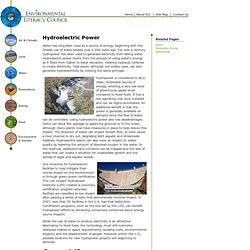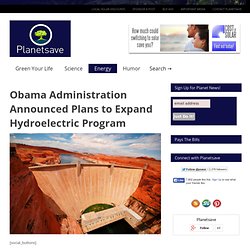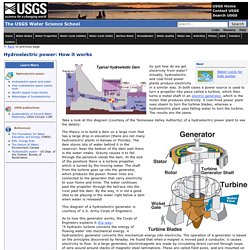

The Environmental Literacy Council - Hydroelectric Power. Water has long been used as a source of energy, beginning with the Greeks use of water wheels over 2,000 years ago.

For over a century, hydropower has been used to generate electricity from falling water. Hydroelectric power stems from the process of using water's energy as it flows from higher to lower elevation, rotating hydraulic turbines to create electricity. Tidal power, although not widely used, can also generate hydroelectricity by utilizing the same principle. Hydropower is considered to be a clean, renewable source of energy, emitting a very low level of greenhouse gases when compared to fossil fuels. It has a low operating cost once installed and can be highly automated. One incentive for hydroelectric facilities to help mitigate their overall impact on the environment is through green power certification. How Hydropower Plants Work HowStuffWorks.com details the basic components of a hydropower plant and how it operates.
Water Power The U.S. References. Obama Wants To Cut Hydropower Funding. Obama Administration Announced Plans to Expand Hydroelectric Program. [social_buttons] July 1, 2009 – The U.S.

Department of Energy Secretary Steven Chu announced today that up to $32 million dollars of Recovery Act funding will be used to expand the harvest of hydroelectric power. “There’s no one solution to the energy crisis, but hydro-power is clearly part of the solution and represents a major opportunity to create more clean energy jobs,” said Secretary Chu. The funding would be used on existing facilities in order to modernize the current infrastructures, increase efficiency and reduce the impact that the facilities have on the environment. “Investing in our existing hydro-power infrastructure will strengthen our economy, reduce pollution and help us toward energy independence,” said Chu. One of the advantages to hydroelectric power (related: Advantages and Disadvantages of Solar Energy) noted by Secretary Chu is that the energy produced can be stored behind the dam.
Projects will be selected in two areas: About the Author. Sustainable energy systems engineering: the complete green building design ... - Peter Gevorkian. INTRODUCTION. Hydroelectric power and water. Basic information about hydroelectricity, USGS Water Science for Schools. Hydroelectric power must be one of the oldest methods of producing power.

No doubt, Jack the Caveman stuck some sturdy leaves on a pole and put it in a moving stream. The water would spin the pole that crushed grain to make their delicious, low-fat prehistoric bran muffins. People have used moving water to help them in their work throughout history, and modern people make great use of moving water to produce electricity. Hydroelectric power for the Nation Although most energy in the United States is produced by fossil-fuel and nuclear power plants, hydroelectricity is still important to the Nation, as about 7 percent of total power is produced by hydroelectric plants.
World distribution of hydropower Hydropower is the most important and widely-used renewable source of energy. Producing electricity using hydroelectric power has some advantages over other power-producing methods. Advantages to hydroelectric power: Disadvantages to power plants that use coal, oil, and gas fuel: Hydroelectric Power: How it works, USGS Water Science for Schools. So just how do we get electricity from water?

Actually, hydroelectric and coal-fired power plants produce electricity in a similar way. In both cases a power source is used to turn a propeller-like piece called a turbine, which then turns a metal shaft in an electric generator, which is the motor that produces electricity. A coal-fired power plant uses steam to turn the turbine blades; whereas a hydroelectric plant uses falling water to turn the turbine.
The results are the same. Take a look at this diagram (courtesy of the Tennessee Valley Authority) of a hydroelectric power plant to see the details: The theory is to build a dam on a large river that has a large drop in elevation (there are not many hydroelectric plants in Kansas or Florida). This diagram of a hydroelectric generator is courtesy of U.S.